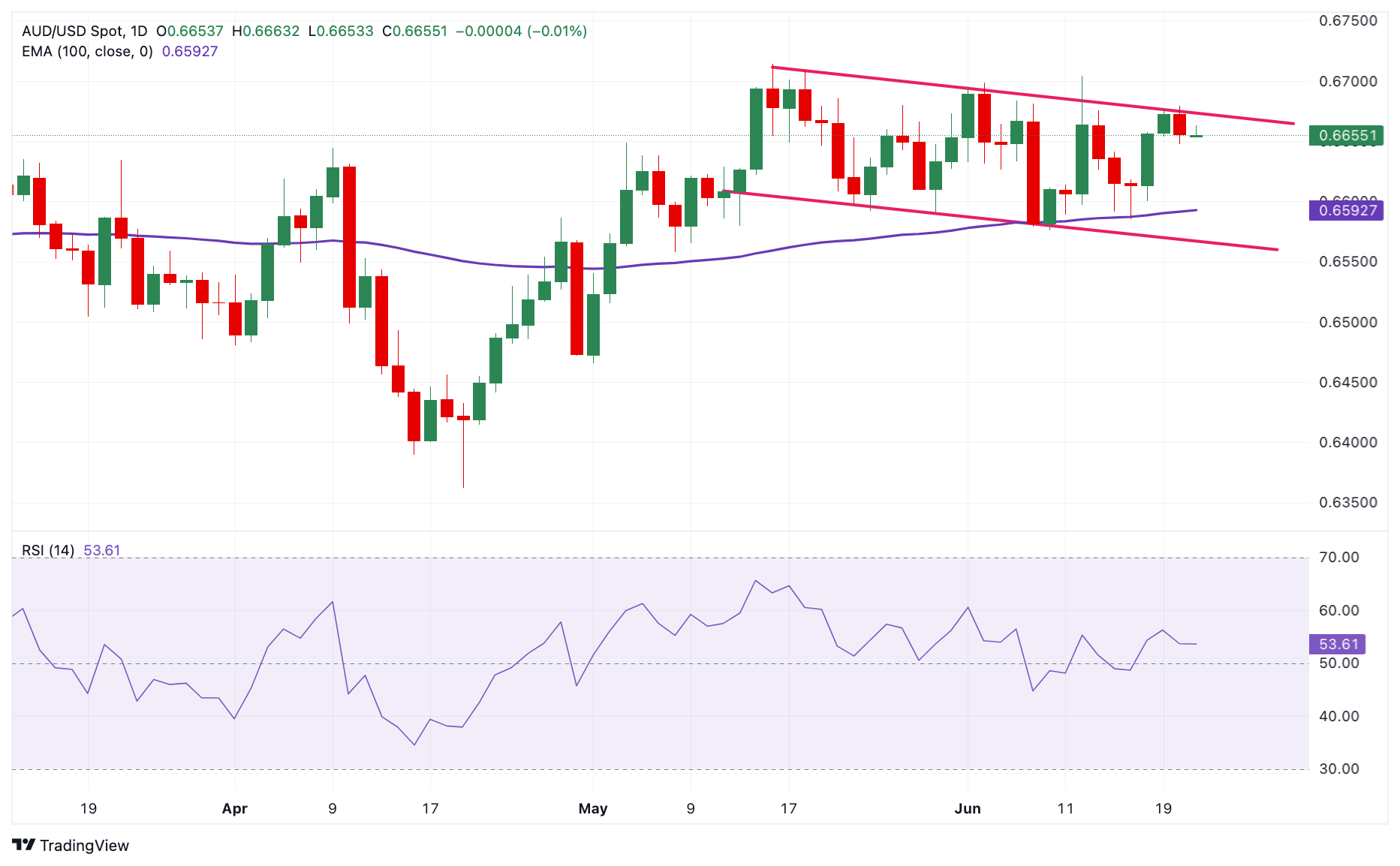- Gold remains bid as lack of Fed clarity and geopolitical frictions persist
- Gold Price Forecast: XAU/USD drifts higher above $4,200 as Fed delivers expected cut
- Gold Price Steady Climb and the Sudden Surge of Silver and Copper: Will Their Bull Run Extend Into 2026?
- Gold Price Forecast: XAU/USD climbs above $4,250 as Fed rate cut weakens US Dollar
- Silver Price Forecast: XAG/USD refreshes record high, looks to build on move beyond $61.00
- U.S. November Nonfarm Payrolls: What Does the Rare "Weak Jobs, Strong Economy" Mix Mean for U.S. Equities?

The Australian Dollar holds positive ground on Thursday.
The Aussie edges higher as Australian PMI reading has maintained expansion in June.
Investors await the advanced US S&P Global PMI data, which is due on Friday.
The Australian Dollar (AUD) trades with mild gains in Thursday’s early Asian session. The Aussie edges higher after the recent Australian Judo Bank PMI report suggested that business activity is still growing despite a slower pace than in March and April. Furthermore, the Reserve Bank of Australia’s (RBA) hawkish hold on Tuesday is likely to underpin the AUD in the near term.
However, the escalating geopolitical tensions in the Middle East after Israeli officials reiterated that the country is ready for an all-out war against Hezbollah, might boost safe-haven currencies like the US Dollar (USD). The advanced US S&P Global Manufacturing and Services PMI will take center stage on Friday. If the US business activity showed an improvement in June, this could further support the Greenback and act as a headwind for the pair.
Daily Digest Market Movers: Australian Dollar remains firm after the country’s PMI data
Advanced Australia's Judo Bank Composite PMI declined in June to 50.6 from 52.1 in May. The Manufacturing PMI dropped to 47.5 in June from 49.7 in the previous reading, weaker than the 50.6 expected. The Services PMI fell to a five-month low of 51.0 in June compared to 51.2 prior, according to the Judo Bank and S&P Global.
US Initial Jobless Claims for the week ending June 15 rose to 238K from the previous reading of 243K, above the market consensus of 235K.
US Building Permits dropped by 3.6% MoM in May from 1.44 million to 1.386 million, while Housing Starts for the same period fell by 5.5% from 1.352 million to 1.277 million.
Richmond Fed President Tom Barkin said on Thursday that the central bank is well-positioned with necessary firepower for job, but will have to maintain a strict data-dependent approach before considering cutting rates.
Minneapolis Fed President Neel Kashkari noted that it could take one to two years for inflation to return to the Fed’s 2% target, per Reuters.
Technical Analysis: AUD/USD’s constructive bias remains in place
The Australian Dollar trades on a stronger note on the day. The AUD/USD pair has remained stuck within a descending trend channel since May 14. The pair maintains a positive outlook beyond the 100-day Exponential Moving Average (EMA) on the daily chart. The 14-day Relative Strength Index (RSI) continues to show bullish momentum, suggesting resistance is more likely to hold than to break.
A decisive break above 0.6675 (the upper boundary of the descending trend channel) could send the pair up to the 0.6700 round mark en route to 0.6760 (high of January 4).
In the bearish case, the key contention level for AUD/USD is seen at 0.6592 (100-day EMA) A breach of the mentioned level will see more loss to 0.6565 (the lower limit of the channel). The additional downside filter to watch is 0.6510, a low of March 22, followed by 0.6465, a low of May 1.
Australian Dollar FAQs
One of the most significant factors for the Australian Dollar (AUD) is the level of interest rates set by the Reserve Bank of Australia (RBA). Because Australia is a resource-rich country another key driver is the price of its biggest export, Iron Ore. The health of the Chinese economy, its largest trading partner, is a factor, as well as inflation in Australia, its growth rate and Trade Balance. Market sentiment – whether investors are taking on more risky assets (risk-on) or seeking safe-havens (risk-off) – is also a factor, with risk-on positive for AUD.
The Reserve Bank of Australia (RBA) influences the Australian Dollar (AUD) by setting the level of interest rates that Australian banks can lend to each other. This influences the level of interest rates in the economy as a whole. The main goal of the RBA is to maintain a stable inflation rate of 2-3% by adjusting interest rates up or down. Relatively high interest rates compared to other major central banks support the AUD, and the opposite for relatively low. The RBA can also use quantitative easing and tightening to influence credit conditions, with the former AUD-negative and the latter AUD-positive.
China is Australia’s largest trading partner so the health of the Chinese economy is a major influence on the value of the Australian Dollar (AUD). When the Chinese economy is doing well it purchases more raw materials, goods and services from Australia, lifting demand for the AUD, and pushing up its value. The opposite is the case when the Chinese economy is not growing as fast as expected. Positive or negative surprises in Chinese growth data, therefore, often have a direct impact on the Australian Dollar and its pairs.
Iron Ore is Australia’s largest export, accounting for $118 billion a year according to data from 2021, with China as its primary destination. The price of Iron Ore, therefore, can be a driver of the Australian Dollar. Generally, if the price of Iron Ore rises, AUD also goes up, as aggregate demand for the currency increases. The opposite is the case if the price of Iron Ore falls. Higher Iron Ore prices also tend to result in a greater likelihood of a positive Trade Balance for Australia, which is also positive of the AUD.
The Trade Balance, which is the difference between what a country earns from its exports versus what it pays for its imports, is another factor that can influence the value of the Australian Dollar. If Australia produces highly sought after exports, then its currency will gain in value purely from the surplus demand created from foreign buyers seeking to purchase its exports versus what it spends to purchase imports. Therefore, a positive net Trade Balance strengthens the AUD, with the opposite effect if the Trade Balance is negative.
Read more
* The content presented above, whether from a third party or not, is considered as general advice only. This article should not be construed as containing investment advice, investment recommendations, an offer of or solicitation for any transactions in financial instruments.


